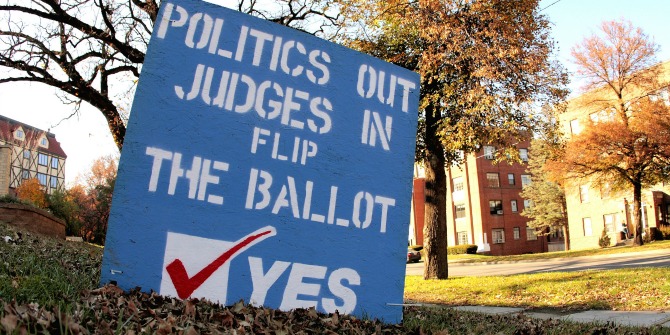
 While most commentators have been focused on the outcome of key Senate races in this year’s midterm elections, it is important to remember that many states were also electing judges for high courts as well this week. Chris W. Bonneau and Jeremy R. Johnson give an overview of the results including a million dollar race in North Carolina, ballot measures on judicial retirement ages, and Tennessee’s vote to allow the governor to appoint judges of the Supreme Court and intermediate appellate court, subject to legislative approval.
While most commentators have been focused on the outcome of key Senate races in this year’s midterm elections, it is important to remember that many states were also electing judges for high courts as well this week. Chris W. Bonneau and Jeremy R. Johnson give an overview of the results including a million dollar race in North Carolina, ballot measures on judicial retirement ages, and Tennessee’s vote to allow the governor to appoint judges of the Supreme Court and intermediate appellate court, subject to legislative approval.
In addition to the elections for Senate, the House, and Governor, several states elected judges for the state high court bench this week. While all incumbents won, and many won handily, there were several hotly contested races. Three states had partisan judicial elections this year, with a total of twelve contested races. Five states had contested non-partisan elections this year for eleven contested seats. In the partisan and nonpartisan races, there were twelve unopposed races across seven states. Fourteen states had retention elections (where there is a referendum on whether or not the judge should have another term), involving 27 incumbents. Additionally, there were several ballot measures where voters had the opportunity to change the method by which judges are selected or alter mandatory retirement provisions. Here, we highlight some of the more interesting contests and results.
Partisan Elections
Texas is one of two states that have a separate Supreme Court and Court of Criminal Appeals. Of the 18 Justices, seven were up for reelection this year. Four incumbents on the Supreme Court defeated their opponents. There were three open seats on the Texas Court of Criminal Appeals, all of which were won by Republicans. The partisan make up of the Texas courts is seventeen Republicans and one Democrat. Democrat Lawrence Meyers was elected to the Court of Criminal Appeals in 1992 as a Republican and has run as such since his election. In 2013, he switched parties and announced that he was running as a Democrat for the Texas Supreme Court. Meyers was defeated by incumbent Justice Jeff Brown receiving only 36.5 percent of the vote. Interestingly, he remains a judge on the Court of Criminal Appeals until his term expires in 2016.
Nonpartisan Elections
Michigan has nominally nonpartisan races, but the candidates have to run in partisan primaries, so their party affiliation is well-known prior to the race. There were two open seats for full terms with five candidates, only one of which was an incumbent. Incumbent Republican Brian Zahra won one of the seats with 32 percent of the vote, while Democrat Richard Bernstein won the second seat with 29 percent of the vote. The other race was for a partial term ending in 2016, which was won by incumbent Republican David Viviano. The partisan makeup of the Michigan Supreme Court remains five Republicans and two Democrats. Ohio uses the same partisan primary, nonpartisan election scheme as Michigan. Both Republican incumbents defeated their opponents. The Ohio Supreme Court remains made up of six Republicans and one Democrat.
Kentucky had four races this year. In three of the seats the incumbents faced no challenge. The only race in Kentucky was between incumbent Justice Michelle Keller and challenger Teresa L. Cunningham. This race was marked by a large disparity in fundraising. Keller raised $87,000 to Cunningham’s $25,000. In Minnesota, incumbent Justices Wilhelmina Wright and David Lellehaug defeated challengers. This race stands out for its lack of fundraising by opponents. Wright and Lellehaug raised $154,000 compared to challengers John Hancock and Michelle L. MacDonald’s anemic $300. Washington had four races, two of which were unopposed. Of the two contested races, both incumbents defeated their challengers with more than 70 percent of the vote.
North Carolina utilizes nonpartisan judicial elections; however, parties are allowed to endorse candidates, so their partisanship is usually well known. There were four contested races in North Carolina. Incumbent Republican Mark Martin ran against fellow Republican Ola M. Lewis to replace retiring Chief Justice Democrat Sarah Parker. Martin’s seat was filled by Democrat challenger Sam Ervin. Democrat incumbent Robin Hudson retained her seat with 52.4 percent of the vote. Incumbent Democrat Cheri Beasley defeated her opponent Republican Michael L. Robinson with just over 50 percent of the vote, a difference of approximately 3,000 votes. This is well within the limit for her opponent to request a recount, although he has yet to do so. It is possible the results of this race may change.
Another notable event for North Carolina is the recent repeal in public financing for judicial candidates. In the past, qualified candidates received $250,000 for the election. This year, the candidates raised almost four million dollars combined with Hudson and Levinson raising $1.24 million in that race alone.
Finally, despite the controversy surrounding the field experiment conducted by political scientists at Stanford and Dartmouth, the results for the two seats on the Montana Supreme Court were unsurprising. Incumbent Justices Mike Wheat and James Rice easily won reelection. Wheat defeated his opponent 59 percent to 40.9 percent despite an almost $85,000 contribution deficit. James Rice outraised his opponent by $75,000 and won his race 78.3 percent to 21.6 percent.
Retention Elections
Unsurprisingly, all of the judges up for retention at the state Supreme Court level kept their jobs. There were a couple of notable challenges to incumbents. In Kansas, Lee Johnson and Eric Rosen both kept their jobs, though they both received less than 55 percent of the vote. This is the closest election in Kansas since at least 1984, and no justice has ever lost. There was an organized campaign to unseat these two justices because they were part of the court majority that overturned death sentences for two people convicted of multiple murders.
In Illinois, incumbent judges need to win 60 percent of the vote to keep their seats. Lloyd Karmeier achieved that—barely—with 61 percent of the vote. In 2004, Karmeier won election to the bench in an election that was the most expensive ever (Illinois initially selects judges in partisan elections, then judges keep their jobs in retention elections), at that time. This year, over $2 million was spent by his supporters and opponents in his retention bid. Retention races are usually characterized by little (if any) campaign fundraising, campaigning, advertising, etc. Not so this race. The major issue was the same as it was in 2004: the battle between business interests and trial lawyers. Just like ten years ago, the candidate backed by business interests prevailed, and Karmeier narrowly avoided being the first Illinois Supreme Court justice to lose his retention bid.
Ballot Measures
There were two ballot measures that sought to either raise or eliminate mandatory retirement ages for judges. Many states require judges to step down when they reach a designated age, usually 70. For the third time in the past eight years, voters in Hawaii resoundingly (77 percent of the vote) rejected an attempt to raise the mandatory retirement age to 80. Likewise, 58 percent of the voters in Louisiana rejected an amendment to the state constitution that would have eliminated the retirement age completely. Thus, judges in both Hawaii and Louisiana will still have to retire once they reach age 70. With people living productive lives even well past the age of 70, many quality and capable judges will continue to be forced off the bench. Issues like this are a cautionary tale about putting too much specific information in a constitution: constitutions are far more difficult to change than statutes, and many voters are skeptical of tinkering around with the document, even for seemingly good ideas.
A related ballot initiative on retirement was passed in New Mexico with 62 percent of the vote. Because judges in New Mexico must initially run in a partisan election (they retain their jobs in retention elections), the state constitution required incumbents to decide by the state’s primary filing deadline in March whether they would stand for retention or retire. The amendment voters approved, which was passed unanimously in both houses of the legislature, now lets the legislature decide the filing deadline for sitting judges. This will likely give incumbents more time to decide whether they want to stay on the bench or retire.

In the biggest constitutional change of the night in terms of the judiciary, Tennessee has eliminated the so-called merit system in favor of a modified federal system. 61 percent of voters in Tennessee voted to allow the governor to appoint judges of the Supreme Court and intermediate appellate court, subject to confirmation by both houses of the legislature. Judges would still have to run in retention elections to keep their seats. So, the big change here is taking power away from the unelected Judicial Nominating Commission (under the old system, this group presented a list of names to the governor, and the governor was constrained to choose from this list; there was no legislative involvement) and vesting it in the elected governor and state legislature. By keeping retention elections, the people remain involved in retaining judges. Interestingly, the amendment also states that a nominee is considered confirmed if the legislative fails to reject him or her within 60 days. This will ensure judges are able to take their positions quickly and will prevent institutional gridlock leading to the understaffing of the bench.
For the second consecutive election cycle, voters in Florida rejected an attempt to tinker with the state’s method of selection. To amend the Florida Constitution, amendments need to have 60 percent of the vote; Amendment 3 only had 48 percent support. This amendment, described by opponents as a court packing plan, would have permitted the governor to name a new judge once the retirement date of an existing judge was known. The reason why critics called this a court packing plan is that 3 judges are going to be forced to retire early in 2019 when they hit the state’s mandatory retirement age. This amendment would have allowed the current governor (who is term limited and cannot run again) to select a replacement for these 3 judges in advance of his leaving office.
Finally, 88 percent of Hawaiians agreed with a unanimous state legislature and amended the constitution to require judicial selection commissions to make their list of nominees public. Thus, when presenting the governor with a list of names to fill a judicial vacancy, that list now also needs to be made public. Previously, the public would only know whom the governor selected and not the list of other potential selectees. This adds more transparency to the system of judicial selection in Hawaii.
Overall, it was a relatively quiet night on the judicial elections front. The biggest news of the night was the voters of Tennessee changing its method of selection. Otherwise, the status quo prevailed.
Featured image credit: Shawn Calhoun (Flickr, CC-BY-NC-2.0)
Please read our comments policy before commenting.
Note: This article gives the views of the authors, and not the position of USApp– American Politics and Policy, nor of the London School of Economics.
Shortened URL for this post: http://bit.ly/1ycVspj
_________________________________
 Chris W. Bonneau – University of Pittsburgh
Chris W. Bonneau – University of Pittsburgh
Chris W. Bonneau is associate professor of political science at the University of Pittsburgh. He primarily studies American politics with an emphasis on judicial politics and public law.
_
 Jeremy R. Johnson – Penn State University
Jeremy R. Johnson – Penn State University
Jeremy R. Johnson is a PhD Student at Penn State University. His research interests are primarily on Judicial Politics, focusing on judicial selection.






